Stephen Morris's Blog, page 51
November 21, 2013
Chrysanthemum
With a history that dates back to 15th century B.C., chrysanthemum mythology is filled with a multitude of stories and symbolism. Named from the Greek prefix “chrys-“ meaning golden (its original color) and “-anthemion,” meaning flower, years of artful cultivation have produced a full range of colors, from white to purple to red. Daisy-like with a typically yellow center and a decorative pompon, chrysanthemums symbolize optimism and joy. They’re the November birth flower, the 13th wedding anniversary flower and the official flower of the city of Chicago. In Japan, there’s even a “Festival of Happiness” to celebrate this flower each year.
Alchemists associate Chrysanthemum with the element fire and its traditional occult or folk-use was always protective: wearing the flowers can protect against the wrath of both gods and evil spirits and a garden in which chrysanthemum blooms is off-limits to evil sprites or demons. Drinking an infusion of the flower can cure drunkenness (hangovers)!
November 17, 2013
Scorpio

A scorpion was sent to kill the hunter Orion for his arrogance.
Scorpio, the eighth astrological sign of the western zodiac governs those born between October 23 and November 22 each year.
In Ancient Egypt, Scorpio was the equivalent of the Serpent. Serpents were worshiped by ancient Egyptians. In Egypt not only are there serpents of the houses, but each quarter in Cairo had a serpent-guardian.
Before the discovery of Pluto in 1930, the planetary ruler of Scorpio was Mars, but modern astrologers tend to use Pluto as the sole ruler.
According to the ancient Greek poet Hesiod the giant huntsman Orion went away to the island of Crete to spend his time hunting in company with goddess Artemis and Leto. Orion threatened to kill every beast, which made the goddess of earth Gaia angry. To punish him for his arrogance she sent against him a huge Scorpion which stung Orion to death. At the prayer of Artemis and Leto, Zeus, the ruler of the Olympian gods, put Orion and the Scorpion among the stars as a memorial of him and what had occurred.
November 9, 2013
St. Martin’s Day II
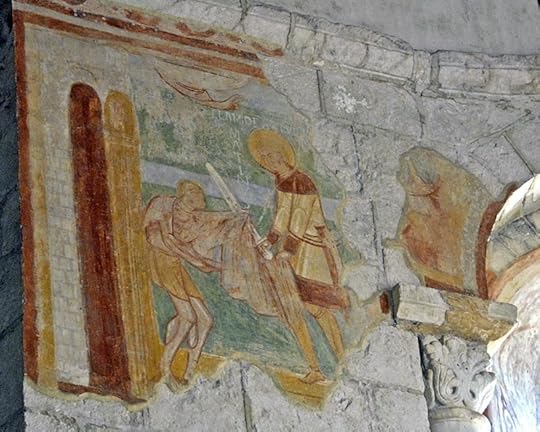
Martin of TOurs cuts his cloak to give to a beggar, depicted on the walls of the church of Saint Hilary, Poitiers.
While Martin was a soldier in the Roman army and deployed in Gaul (modern-day France), he experienced a vision, which became the most-repeated story about his life. One day as he was approaching the gates of the city of Amiens, he met a scantily clad beggar. He impulsively cut his military cloak in half to share with the man. That night, Martin dreamed of Jesus wearing the half-cloak he had given away. He heard Jesus say to the angels: “Here is Martin, the Roman soldier who is not baptized; he has clad me.” In another version, when Martin woke, he found his cloak restored to wholeness. The dream confirmed Martin in his piety, and he was baptized at the age of 18.
The part kept by himself became the famous relic preserved in the oratory of the Merovingian kings of the Franks at the Marmoutier Abbey near Tours. During the Middle Ages, the supposed relic of St. Martin’s miraculous cloak, (cappa Sancti Martini) was carried by the king even into battle, and used as a holy relic upon which oaths were sworn. The cloak is first attested in the royal treasury in 679, when it was conserved at the palatium of Luzarches, a royal villa that was later ceded to the monks of Saint-Denis by Charlemagne, in 798/99.
The priest who cared for the cloak in its reliquary was called a cappellanu, and ultimately all priests who served the military were called cappellani. The French translation is chapelains, from which the English word chaplain is derived. One of the many services a chaplain can provide is spiritual and pastoral support for military service personnel by performing religious services at sea or in the battlefield.
A similar linguistic development took place for the term referring to the small temporary churches built for the relic. People called them “capella”, the word for a little cloak. Eventually, such small churches lost their association with the cloak, and all small churches began to be referred to as “chapels”.
According to the most widespread variation of the cloak story, Saint Martin cut off half of his cloak in order to offer it to a beggar and along the way, he gave the remaining part to a second beggar. As he faced a long ride in a freezing weather, the dark clouds cleared away and the sun shone so intensely that the frost melted away. Such weather was rare for early November, so was credited to God’s intervention. The phenomenon of a sunny break to the chilly weather on Saint Martin’s Day (11 November) is called Verão de São Martinho (Saint Martin’s Summer, veranillo de san Martín in Spanish) in honor of the cloak legend.
November 2, 2013
St. Martin’s Day I
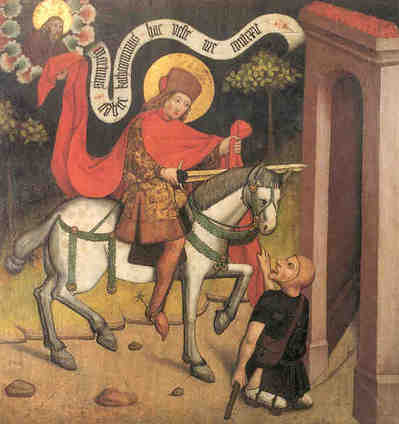
Martin of Tours meets the beggar and is blessed by Christ because he gave the beggar 1/2 of his cloak.
Martin of Tours (died in November, 397) was a Bishop of Tours, whose shrine in France became a famous stopping-point for pilgrims on the road to Santiago de Compostela. Around his name much legendary material accrued, and he has become one of the most familiar and recognizable Christian saints. As he was born in what is now Szombathely, Hungary, spent much of his childhood in Pavia, Italy, and lived most of his adult life in France, he is considered a spiritual bridge across Europe.
From the late 4th century to the late Middle Ages, much of Western Europe, including Great Britain, engaged in a period of fasting beginning on the day after St. Martin’s Day, November 11. This fast period lasted 40 days, and was, therefore, called Quadragesima Sancti Martini, which means in Latin “the forty days of St. Martin.” At St. Martin’s eve and on the feast day, people ate and drank very heartily for a last time before they started to fast. This fasting time was later called “Advent” by the Church and was considered a time for spiritual preparation for Christmas.
On St. Martin’s Day, children in Flanders, the southern and north-western parts of the Netherlands, and the Catholic areas of Germany and Austria still participate in paper lantern processions. Often, a man dressed as St. Martin rides on a horse in front of the procession. The children sing songs about St. Martin and about their lanterns. The food traditionally eaten on the day is goose, a rich bird. According to legend, Martin was reluctant to become bishop, which is why he hid in a stable filled with geese. The noise made by the geese betrayed his location to the people who were looking for him.
In the east part of the Belgian province of East-Flanders (Aalst) and the west part of West Flanders (Ypres), traditionally children receive presents from St. Martin on November 11, instead of from Saint Nicholas on December 6 or Santa Claus on December 25. They also have lantern processions, for which children make lanterns out of beets. In recent years, the lantern processions have become widespread as a popular ritual, even in Protestant areas of Germany and the Netherlands (even though most Protestant churches no longer officially recognize Saints).
October 26, 2013
Hallowe’en
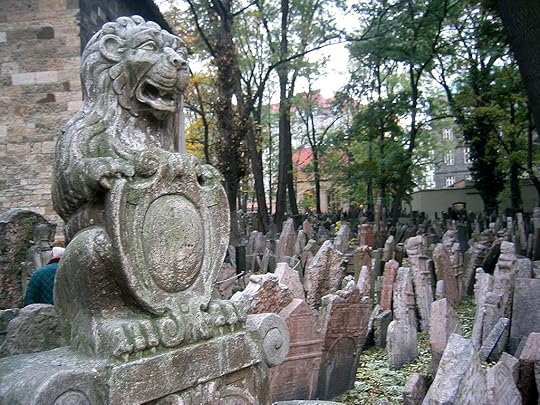
The Jewish Cemetery in Prague. The doorways between the living and the dead were thought to open on the Celtic feast of Samhain.
The word Halloween was first used in the 16th century and represents a Scottish variant of the fuller All Hallows’ Eve (‘evening’), that is, the night before All Hallows’ Day. Although the phrase All Hallows’ is found in Old English (ealra hālgena mæssedæg, mass-day of all saints), All Hallows’ Eve is itself not seen until 1556. In traditional European cultures, the festival was considered the first day of winter; thus, the holidays of Christmas and the December solstice were MID-winter (as many Christmas carols refer to it).
Though the origin of the word Halloween is Christian, the holiday is commonly thought to have partial pagan roots. Historian Nicholas Rogers, exploring the origins of Halloween, notes that while “some folklorists have detected its origins in the Roman feast of Pomona, the goddess of fruits and seeds, or in the festival of the dead called Parentalia, it is more typically linked to the Celtic festival of Samhain“, which comes from the Old Irish for “summer’s end”.[12] Samhain was the first and most important of the four quarter days in the medieval Gaelic (Irish, Scottish, and Manx) calendar. It was held on or about October 31 – November 1 and kindred festivals were held at the same time of year in other Celtic lands; for example the Calan Gaeaf (in Wales), Kalan Gwav (in Cornwall) and Kalan Goañv (in Brittany). It marked the end of the harvest season and the beginning of winter or the ‘darker half’ of the year.
Samhain (like Beltane, on February 1-2) was seen as a time when the ‘door’ to the Otherworld opened enough for the souls of the dead, and other beings such as fairies, to come into our world. The souls of the dead were said to revisit their homes on Samhain. Lewis Spence described it as a “feast of the dead” and “festival of the fairies”. However, harmful spirits and fairies were also thought to be active at Samhain. People took steps to allay or ward-off these harmful spirits/fairies, which is thought to have influenced today’s Halloween customs. The practice of lighting bonfires during Hallowmas may have been a Christianized one, as the Celts lit bonfires during Samhain as well.
October 20, 2013
Marigold, the “birth flower” of October

Marigold blossoms can be strung between doorposts to keep evil out of the house. If a girl steps onmarigold petals with her bare feet, she will be able to understand the languages of birds.
The flower symbolism associated with marigolds is indicated in the name: Mary’s Gold. Marigold flowers were “golden gifts” offered to the Virgin by the poor who could not afford to give actual gold. Marigolds were used in Mary Gardens. Marigolds are symbolic of passion and creativity. Marigolds are also known as the “Herb of the Sun.” Marigolds have been used as love charms and incorporated into wedding garlands. In some cultures, marigold flowers have been added to pillows to encourage prophetic or psychic dreams.
The flower symbolism associated with marigold is grief, despair and sorrow. Marigold blossoms in wine are said to ease indigestion and the petals are used in ointments to cure skin irritations, jaundice, sore eyes and toothaches.
Like the sunflower, the marigold blossom follows the sun; as a result, it has earned the nickname “Sun’s Bride.”
In Germany, the flower was often called ‘monk’s head’ because when stripped of its petals, the remains look like a monk’s tonsure.
It is believed that when Shakespeare wrote about “merrybuds,” he was referring to the blossoms of marigold.
October 11, 2013
Opal, the birthstone of October

An opal could bring either good fortune or death, as it was a source of liminal power that never left unaltered the person who wore it.
The name opal is derived from the Sanskrit word “upala,” as well as the Latin “opalus,” meaning “precious stone.” Opal is a gemstone of much variety; the ancient Roman natural historian Pliny once described it in the following way:
“… it is made up of the glories of the most precious stones. To describe it is a matter of inexpressive difficulty: There is in it the gentler fire of the ruby, the brilliant purple of the amethyst, the sea-green of the emerald, all shining together in an incredible union.”
To ancient Romans, the opal was a symbol of love and hope. Orientals called it the “anchor of hope.” Arabs say it fell from the heavens in flashes of lightning. It was believed to make its wearer invisible, hence the opal was the talisman of thieves and spies.
During the Medieval period, a change in color intensity of an opal was believed to indicated if its wearer was ill or in good health. The opal was supposed to maintain a strong heart, prevent fainting, protect against infection, and cleanse foul-smelling air. The stone, as in ancient times, was still regarded as a symbol of hope.
But the opal’s reputation changed in the mid-14th century. The Black Death swept across Europe, killing one quarter of its population. The gem was believed to be the cause of death. When worn by someone struck with the deadly plague, it would appear brilliant only until the person died. Then it would change in appearance, losing its luster. In reality, it was the sensitivity of this stone to changes in temperature that altered its appearance, as the heat from a burning fever gave way to the chill of death.
In Elizabethan England, the opal was treasured for its beauty. Shakespeare wrote of it in the Twelfth Night as the “queen of gems.” Queen Victoria presented her children with opal jewelry, thus making the stone popular. But the stone continued to have a mixed reputation, chiefly due to a novel written by Sir Walter Scott in 1887 that depicted it as a stone of evil.
October 5, 2013
Libra (September 23 — October 22)
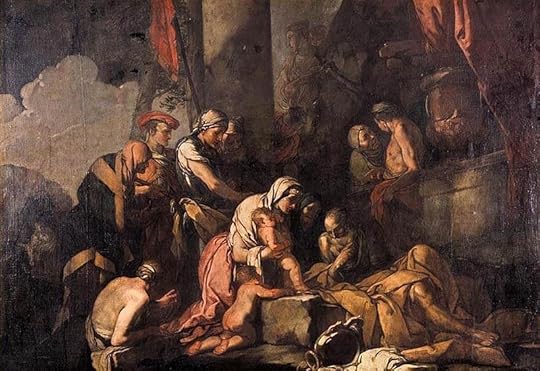
The infant Narcissus is presented to the aged prophet Tiresias. Tiresias the prophet was placed in the sky as the constellation Libra by Hera.
Libra, the scales of justice, is the astrological sign that governs those born September 23 to October 22 each year.
Libras are first and foremost focused on others and how they relate to them. For a Libra, everything is better if it’s done as a pair. Libras are good when paired up, too, since they epitomize balance, harmony and a sense of fair play. While they are true team players at work, their favorite partnership is at home: marriage. Libras feel most complete when they are coupled up with their lover, forever.
It’s the Scales that symbolize Libra, and just like that balancing mechanism wants to stay even, Libras want to be on an even keel. Think of the Scales of Justice and how they work at striking the right balance. Likewise, Libras are objective, just and want to do what’s best for everyone. It’s possible, though, that this penchant for fairness is for a different reason: Libras abhor conflict. The scales study every possible angle in the hopes of achieving peace and harmony, so much so that others may see them as fickle and indecisive. If that’s what it takes to avoid a confrontation, that’s fine with the Scales. The Libra-born are keen strategists, organizing groups with poise and getting the job done. Further, you can expect the Scales to be companionable, sociable folks.
Libra is ruled by Venus. In ancient Roman mythology, Venus was a smooth seductress who was at her best amid pleasurable excess and Libras are certainly carrying the torch for her today. The Scales are cultured, refined and love beautiful things. Most of all, they love beautiful people, which is why Libras do so well at cocktail parties or at the theater, opera or ballet. Those born under this sign always have the right thing to say.
You can expect the Scales to make a fair argument, too, since they live by the principles of diplomacy and compromise. When this approach doesn’t work, however, Libras are not above using their persuasive charms to get their way. Libras are polite and don’t like to fight, far preferring to talk things through.
The great strength of the Libra-born is their quest for fairness, peace and harmony. That the Scales are the great diplomats of the zodiac further helps their case.
September 29, 2013
Michaelmas
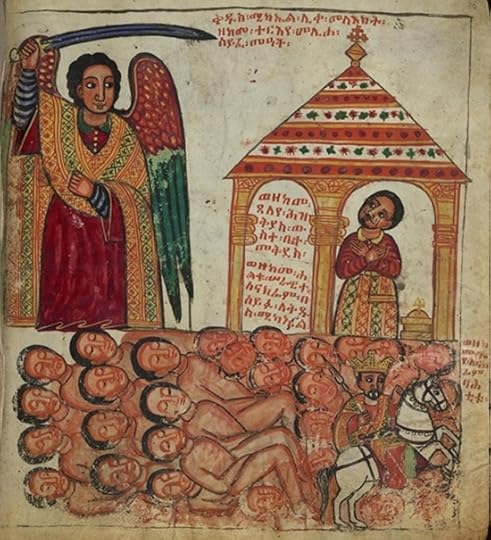
This 17rh century Ethiopian manuscript illumination shows the Archangel Michael helping Hezekiah, king of Judah, defeat Sennacherib of Assyria.
Michaelmas, the feast of Saint Michael the Archangel (also called the Feast of Saint Michael and All Angels) is a day in the Western Christian calendar which occurs on 29 September. Because it falls near the equinox, it is associated in the northern hemisphere with the beginning of autumn and the shortening of days. In medieval England, Michaelmas marked the ending and beginning of the husbandman’s year.
The Archangel Michael is the greatest of all the Archangels and is honoured for defeating Lucifer in the war in heaven. He is one of the principal angelic warriors, seen as a protector against the dark of night, and the administrator of cosmic intelligence. Michaelmas has also delineated time and seasons for secular purposes as well; in the United Kingdom and Ireland, “Michaelmas term” is still the first quarter of the academic year.
On manors, it was the day when a reeve was elected from the peasants. Traditional meal for the day includes goose (a “stubble-goose”, i.e. one prepared around harvest time) and a special cake called a St Michael’s bannock.
According to an old legend, blackberries should not be picked after this date. This is because, so folklore goes, Satan was banished from Heaven on this day, fell into a blackberry bush and cursed the brambles as he fell into them. In Yorkshire, it is said that the devil had spat on them. According to Morrell (1977), this old legend is well known in all parts of the United Kingdom, even as far north as the Orkney Islands. In Cornwall, a similar legend prevails, however, the saying goes that the devil urinated on them.
September 25, 2013
A Great Day at the Brooklyn Book Festival!
We had a great day at the Brooklyn Book Festival on sunny Sunday, September 22! Enjoy the photos, courtesy of Elliot Kreloff.








